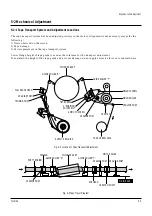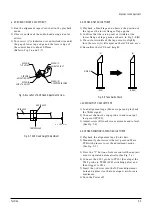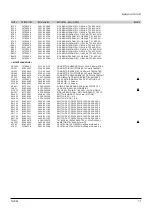
Alignment and Adjustment
Toshiba
5-5
a. ACE HEAD HEIGHT ADJUSTMENT
1) Run the alignment tape (Color bar) in the playback
mode.
2) Observe surface of the audio head using a dental
mirror.
3) Turn screw (C) clockwise or counterclockwise until
the gap of lower tape edge and the lower edge of
the control head is about 0.25mm.
(Refer to Fig. 5-6 and 5-7)
Fig. 5-6 Location of ACE Head Adjustment Screw
Fig. 5-7 ACE Head Height Adjustment
SCREW (A)
TLIT ADJUST
X-POSITION
ADJUSTING SLIT
SCREW (C)
HEIGHT ADJUST
SCREW (D)
X-POSITION LOCKING
SCREW (B)
AZIMUTH ADJUST
0 ~ 0 .25 mm
AUDIO HEAD
VIDEO HEAD
CONTROL HEAD
b. ACE HEAD TILT ADJUSTMENT
1) Playback a blank tape and observe the position of
the tape at the lower flange of tape guide.
2) Confirm that there is no curl or wrinkle at the
lower flange of tape guide as shown in Fig. 5-8 (B).
3) If a curl or wrinkle of the tape occurrs, slightly
turn the screw (A) tilt adjust on the ACE head ass’y.
4) Reconfirm the ACE head height.
Fig. 5-8 Tape Guide Check
c. AUDIO AZIMUTH ADJUSTMENT
1) Load alignment tape (Mono scope) and playback
the 7KHz signal.
2) Connect channel-1 scope probe to audio output
test point (TP302).
3) Adjust screw (B) to achieve maximum audio level.
(See Fig. 5-6)
d. ACE HEAD POSITION (X-POINT) ADJUSTMENT
1) Playback the alignment tape (Color bar).
2) Monmently short-circuit the test point on Main
PCB with pincers to set the adjustment mode.
(See Fig. 5-2 )
3) Press the “5” button of remote control then adjust-
ment is operated automatically. (See Fig. 5-1)
4) Connect the CH-1 probe to TP301 (Envelope) the
CH-2 probe to TP602 (H’D switching pulse) and
then trigger to CH-1.
5) Insert the (-) driver into the X-Point adjustment
hole and adjust it so that envelope wavwform is
maximum.
6) Turn the Power off.
(A)
(B)
(BAD)
WRINKLE
(GOOD)
















































